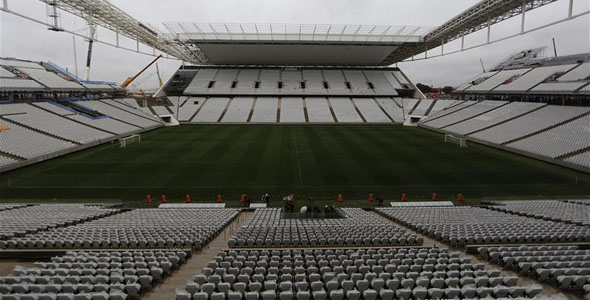Brazil Stadiums Suffer as Country Fails to Leave Post-World Cup 2014 Legacy
October 9, 2015
Over a year after the 2014 World Cup in Brazil, it is fair to wonder what legacy the tournament has left behind in the country and specifically, how many of the 12 stadiums newly built or refurbished for the tournament, are being put to good use?
The answer, underwhelmingly, is not very many.
A large number of the stadiums have gone on to become white elephants post the 2014 World Cup, with some having no use at all.
More than $3 billion was spent on the stadiums, which hosted one of the best World Cups in recent memory.
With the country currently going through economic troubles, it doesn’t reflect well that millions have been spent on state-of-the-art stadiums that are not being used frequently and are not generating much revenue.
FIFA regulations require only eight venues for a World Cup, but Brazil decided to go one better and build extra new stadiums from scratch, thus making a total of 12 stadiums. Which in hindsight, despite staging a hugely successful and memorable World Cup, has turned out to be a bad move.
It is even more worrying with the country set to host another major sporting event in 2016, the Olympic Games.
NPR’s Lourdes Garcia Navarro wrote about the state of some of the stadiums in Brazil and it didn’t make for positive reading for the Brazilian natives.
Brasilia & Cuiaba
The most expensive World Cup stadium was built in the country’s capital of Brasilia, with a cost of $550 million.
The stadium is now reportedly being used as a parking lot for buses.

The stadium in Cuiaba cost the country $250m to build and has seen it make headlines for reasons unrelated to football in the past year.
Since the end of the World Cup it has been closed for repair work and most notably, according to a report by Brazilian publication Globo, homeless people have been living in the unused locker rooms of the stadium.
According to AP, the local football teams generate between 500-1000 fans per game, with the capacity of the stadium standing at 42,000.
Natal & Manaus
The stadiums in Natal and Manaus, built with public funding, have both been put up for sale as they are struggling with the financial costs of running the venues, according to NPR’s Lourdes Garcia Navarro.
Speaking to NPR, sports reporter Leânderson Lima said Brazil was always going to face problems with these stadiums as the cities don’t possess a strong following for their local football teams.

“The local league games have very low attendance, and it costs a lot of money to put games on at the arena,” said Lima.
“So, in Manaus nowadays, local team matches actually take place in two training centers, and not in the World Cup stadium.”
The Arena Amazonia in Manaus was built for $300m, despite the region having no top-flight football team.
The stadium had only hosted around 11 events in the five months after the tournament, which is much less than anticipated as concerts and other events were expected to generate much of the funds for the stadium.
According to the NPR report, the Arena das Dunas in Natal is “trying to make money by hosting weddings and kids’ parties — with little luck”.

Arena Corinthians
Construction work on the Arena Corinthians in Sao Paulo was only finished in May, 10 months after the World Cup ended.
The stadium was still used for the tournament however, but with a temporary stand. Uruguay’s 2-1 win over England at the World Cup was one of the games held at the stadium.
According to a report by AP, despite Corinthians, one of the biggest and most popular clubs in Brazil, playing their home games at the stadium, the club are not benefiting from this.

“Attendance has significantly increased at the stadium owned by popular team Corinthians, but the club can’t keep any of the revenue because the money is still being used to pay for its construction,” according to AP.
Legacy
It is clear the 2014 World Cup hasn’t left a great legacy in the country, with financial trouble the only real lasting memory.
With Rio de Janeiro set to host the 2016 Olympics, Brazil’s sports minister admitted that the World Cup didn’t leave the desired legacy, but doesn’t expect the same from the Olympics.
Speaking to Reuters about the Rio 2016 Games, he said: “Differently from the World Cup, we are leaving a legacy.”
The effect the building of these stadiums has had on Brazil and its economy is surely a lesson to all nations wishing to host major sporting events and the implications it can have if the necessary planning isn’t carried out before and after the event.
It is extremely rare for a nation to host the two biggest sporting events in the world consecutively and it’ll remain to be seen if Brazil can learn from the mistakes of the World Cup and regain the trust of taxpayers by staging a successful Olympics in 2016 and this time, leaving legacy that benefits the nation.


